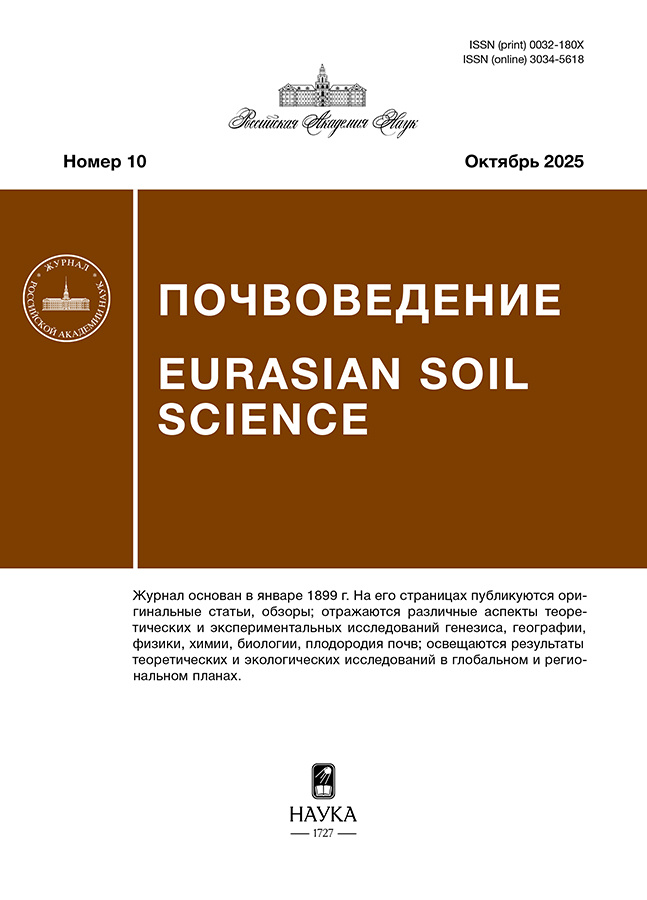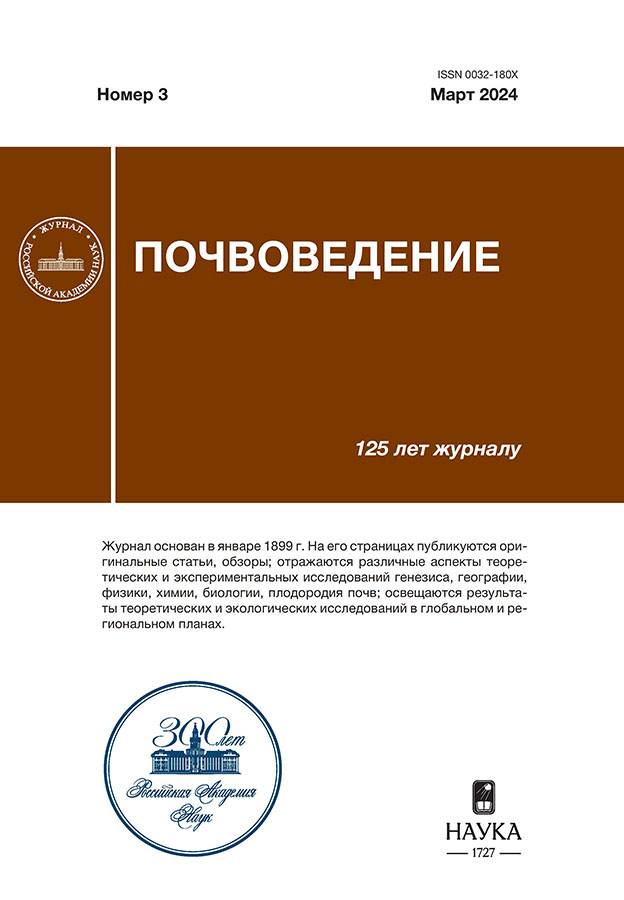Сезонное влияние пирогенного угля на надземное и подземное разложение различных типов опада в бореальных лесах
- Авторы: Брянин С.В.1, Кондратова А.В.1, Данилов А.В.1, Суслопарова Е.С.1
-
Учреждения:
- Институт геологии и природопользования ДВО РАН
- Выпуск: № 3 (2024)
- Страницы: 506-516
- Раздел: ДЕГРАДАЦИЯ, ВОССТАНОВЛЕНИЕ И ОХРАНА ПОЧВ
- URL: https://kld-journal.fedlab.ru/0032-180X/article/view/666660
- DOI: https://doi.org/10.31857/S0032180X24030104
- EDN: https://elibrary.ru/YHTMJR
- ID: 666660
Цитировать
Полный текст
Аннотация
Уголь является устойчивым продуктом лесных пожаров, накапливающимся в слое подстилки и почвах бореальных лесов. Поэтому разложение опада и корней, как один из ключевых процессов в цикле углерода, в почвах бореальных лесов практически повсеместно протекает в присутствии угля. К настоящему времени имеются крайне скудные сведения о влиянии угля на процесс разложения опада в бореальных лесах, и большинство из них не рассматривают холодный период, который в этой зоне длится в среднем полгода. Целью работы было выявление сезонного влияния угля на разложение растительного опада разного качества (хвои лиственницы, листьев березы, трав и смеси этих видов опада) на поверхности почв и корней этих же видов в почве. В полевом “litterbag” эксперименте установлено, что уголь ускорял разложение опада и его влияние было видоспецифическим. Ускорение потери массы в присутствии угля происходило для трудноразлагаемого наземного опада (хвои) и всех видов корней в холодный период. В теплый период ускорение разложения в присутствии угля наблюдалось только для хвои и не наблюдалось для корней. Таким образом, исследование показало большее влияние угля на внутрипочвенное разложение, особенно в холодный период. Сезонное воздействие угля установлено впервые и должно учитываться как важный фактор гумусообразования и динамики углерода в почвах бореальных лесов.
Ключевые слова
Полный текст
Открыть статью на сайте журналаОб авторах
С. В. Брянин
Институт геологии и природопользования ДВО РАН
Email: kondratova.ava@gmail.com
Россия, Благовещенск
А. В. Кондратова
Институт геологии и природопользования ДВО РАН
Автор, ответственный за переписку.
Email: kondratova.ava@gmail.com
Россия, Благовещенск
А. В. Данилов
Институт геологии и природопользования ДВО РАН
Email: kondratova.ava@gmail.com
Россия, Благовещенск
Е. С. Суслопарова
Институт геологии и природопользования ДВО РАН
Email: kondratova.ava@gmail.com
Россия, Благовещенск
Список литературы
- Базилевич Н.И., Титлянова А.А., Смирнов В.В., Родин Л.Е., Нечаева Н.Т., Левин Ф.И. Методы изучения биологического круговорота в различных природных зонах. М.: Мысль, 1978. 185 с.
- Караваева Н.А, Прокопчук В.Ф. Формирование почв с бурым профилем на севере Приамурья и Сахалина // Почвоведение. 2004. № 9. С. 1029–1039.
- Сапронов Д.В. Выделение СО2 из образцов почв различных природных зон России при промерзании–оттаивании в лабораторных условиях // Почвоведение. 2021. № 8. С. 935–945. https://doi.org/10.31857/S0032180X21080141
- Семенов В.М., Лебедева Т.Н., Зинякова Н.Б., Хромычкина Д.П., Соколов Д.А., Лопес де Гереню В.О., Кравченко И.К., Ли Х., Семенов М.В. Зависимость разложения органического вещества почвы и растительных остатков от температуры и влажности в длительных инкубационных экспериментах // Почвоведение. 2022. № 7. С. 860–875. https://doi.org/.31857/S0032180X22070085
- Семенов В.М., Паутова Н.Б., Лебедева Т.Н., Хромычкина Д.П., Семенова Н.А., Лопес де Гереню В.О. Разложение растительных остатков и формирование активного органического вещества в почве инкубационных экспериментов // Почвоведение. 2019. № 10. С. 1172–1184.
- Шапченкова О.А., Краснощеков Ю.Н., Лоскутов С.Р. Использование методов термического анализа для оценки органического вещества почв, пройденных пожарами // Почвоведение. 2011. № 6. С. 738–747.
- Цибарт А.С., Геннадиев А.Н. Влияние пожаров на свойства лесных почв Приамурья (Норский заповедник) // Почвоведение. 2008. № 7. С. 783–792.
- Abiven S., Andreoli R. Charcoal does not change the decomposition rate of mixed litters in a mineral cambisol: A controlled conditions study // Biol Fertil Soils. 2011. V. 47(1). P. 111–114. https://doi.org/10.1007/s00374-010-0489-1.
- Berg B., McClaugherty C. Plant Litter. Decomposition, Humus Formation, Carbon Sequestration. Berlin, Heidelberg: Springer-Verlag GmbH, 2014. 315 p.
- Bleak A.T. Disappearance of plant material under a winter snow cover // Ecology. 1970. V. 51(5). P. 915–917. https://doi.org/10.2307/1933989.
- Bokhorst S., Metcalfe D.B., Wardle D.A. Reduction in snow depth negatively affects decomposers but impact on decomposition rates is substrate dependent // Soil Biol. Biochem. 2013. V. 62. P. 157–164. https://doi.org/10.1016/j.soilbio.2013.03.016.
- Bryanin S., Abramova E., Makoto K. Fire-derived charcoal might promote fine root decomposition in boreal forests // Soil Biol. Biochem. 2018. V. 116. P. 1–3. https://doi.org/10.1016/j.soilbio.2017.09.031.
- Bryanin S.V., Sorokina O.A. Effect of soil properties and environmental factors on chemical compositions of forest soils in the Russian Far East // J. Soils Sediments. 2019. V. 19(3). P. 1130–1138. https://doi.org/10.1007/s11368-018-2141-x.
- Coq S., Souquet J.M., Meudec E., Cheynier V., Hättenschwiler S. Interspecific variation in leaf litter tannins drives decomposition in a tropical rain forest of French Guiana // Ecology. 2010. V. 91(7). P. 2080–2091. https://doi.org/10.1890/09-1076.1
- Cornwell W.K., Cornelissen J.H.C., Amatangelo K. et al. Plant species traits are the predominant control on litter decomposition rates within biomes worldwide // Ecol. Lett. 2008. V. 11(10). P. 1065–1071. https://doi.org/10.1111/j.1461-0248.2008.01219.x.
- Cross A., Sohi S.P. The priming potential of biochar products in relation to labile carbon contents and soil organic matter status // Soil. Biol. Biochem. 2011. V. 43(10). P. 2127–2134. https://doi.org/10.1016/j.soilbio.2011.06.016
- Gartner T.B., Cardon Z.G. Decomposition dynamics in mixed-species leaf litter // Oikos. 2004. V. 104. P. 230–246. https://doi.org/10.1111/j.0030-1299.2004.12738.x
- Goldammer J.G., Furyaev V.V. Fire in Ecosystems of Boreal Eurasia: Ecological Impacts and Links to the Global System. 1996. P. 1–20.
- Gower S.T., Krankina O., Olson R.J., Apps M., Linder S., Wang C. Net Primary production and carbon allocation patterns of boreal forest ecosystems // Ecol. Appl. 2001. V. 11(5). P. 1395–1411.
- Hobbie S.E., Chapin F.S. Winter regulation of tundra litter carbon and nitrogen dynamics // Biogeochemistry. 1996. V. 35(2). P. 327–338. https://doi.org/10.1007/BF02179958.
- Hobbie S.E., Gough L. Litter decomposition in moist acidic and non-acidic tundra with different glacial histories // Oecologia. 2004. V. 140(1). P. 113–124. https://doi.org/10.1007/s00442-004-1556-9.
- Kuzyakov Y., Subbotina I., Chen H., Bogomolova I., Xu X. Black carbon decomposition and incorporation into soil microbial biomass estimated by 14C labeling // Soil Biol. Biochem. 2009. V. 41(2). P. 210–219. https://doi.org/10.1016/j.soilbio.2008.10.016
- Lehmann J. A handful of carbon // Nature. 2007. V. 447(7141). P. 143–144. https://doi.org/10.1038/447143a
- Li Y., Hu S., Chen J., Müller K., Li Y., Fu W., Lin Z., Wang H. Effects of biochar application in forest ecosystems on soil properties and greenhouse gas emissions: a review // J. Soils Sediments. 2018. V. 18(2). P. 546–563. https://doi.org/10.1007/s11368-017-1906-y
- Lu Y., Zhang L., Li K., Ni R., Han R., Li C., Zhang C., Shen W., Zhang Z. Leaf and root litter species identity influences bacterial community composition in short-term litter decomposition // Forests. 2022. V. 13(9). P. 1402. https://doi.org/10.3390/f13091402
- Makoto K., Koike T. Charcoal ecology: Its function as a hub for plant succession and soil nutrient cycling in boreal forests // Ecol. Res. 2021. V. 36(1). P. 4–12. https://doi.org/10.1111/1440-1703.12179
- Makoto K., Tamai Y., Kim Y.S., Koike T. Buried charcoal layer and ectomycorrhizae cooperatively promote the growth of Larix gmelinii seedlingsb // Plant and Soil. 2010. V. 327(1-2). P. 143–152. https://doi.org/10.1007/s11104-009-0040-z
- Makoto K., Nemilostiv Y.P., Zyryanova O.A., Kajimoto T., Matsuura Y., Yoshida T., Satoh F., Sasa K., Koike T. Regeneration after forest fires in mixed conifer broad-leaved forests of the amur region in far eastern Russia: the relationship between species specific traits against fire and recent fire regimes // Eurasian J. For. Res. 2007. V. 10(1). P. 51–58.
- Makkonen M., Berg M.P., Handa I.T., Hättenschwiler S., van Ruijven J., van Bodegom P.M., Aerts R. Highly consistent effects of plant litter identity and functional traits on decomposition across a latitudinal gradient // Ecol Lett. 2012. V. 15(9). P. 1033–1041. https://doi.org/10.1111/j.1461-0248.2012.01826.x
- Matovic D. Biochar as a viable carbon sequestration option: Global and Canadian perspective // Energy. 2011. V. 36(4). P. 2011–2016. https://doi.org/10.1016/j.energy.2010.09.031
- McLauchlan K.K., Higuera P.E., Miesel J. et al. Fire as a fundamental ecological process: Research advances and frontiers // J. Ecol. 2020. V. 108(5). P. 2047–2069. https://doi.org/10.1111/1365-2745.13403
- Minamino Y., Fujitake N., Suzuki T., Yoshitake S., Koizumi H., Tomotsune M. Effect of biochar addition on leaf-litter decomposition at soil surface during three years in a warm-temperate secondary deciduous forest, Japan // Sci. Rep. 2019. V. 9(16961). https://doi.org/10.1038/s41598-019-53615-2
- Olson J.S. energy storage and the balance of producers and decomposers in ecological systems // Ecology. 1963. V. 44(2). P. 322–331. https://doi.org/10.2307/1932179
- Pimm S., Roulet N., Weaver A. Boreal forests’ carbon stores need better management // Nature. 2009. V. 462. P. 276–276. https://doi.org/10.1038/462276a
- Pingree M.R.A., DeLuca E.E., Schwartz D.T., DeLuca T.H. Adsorption capacity of wildfire-produced charcoal from Pacific Northwest forests // Geoderma. 2016. V. 283. P. 68–77. https://doi.org/10.1016/j.geoderma.2016.07.016
- Pluchon N., Gundale M.J., Nilsson M.-C., Kardol P., Wardle D.A. Stimulation of boreal tree seedling growth by wood-derived charcoal: Effects of charcoal properties, seedling species and soil fertility // Funct. Ecol. 2014. V. 28(3). P. 766–775. https://doi.org/10.1111/1365-2435.12221
- Pluchon N., Vincent A.G., Gundale M.J., Nilsson M.-C., Kardol P., Wardle D.A. The impact of charcoal and soil mixtures on decomposition and soil microbial communities in boreal forest // Appl. Soil Ecol. 2016. V. 99. P. 40–50. https://doi.org/10.1016/j.apsoil.2015.11.020
- Pochikalov A.V., Karelin D.V. A field study of tundra plant litter decomposition rate via mass loss and carbon dioxide emission: The role of biotic and abiotic controls, biotope, season of year, and spatial-temporal scale // Biol. Bull. Rev. 2015. V. 5. P. 1–16. https://doi.org/10.1134/S2079086415010077
- Prescott C.E. Litter decomposition: What controls it and how can we alter it to sequester more carbon in forest soils? // Biogeochemistry. 2010. V. 101(1-3). P. 133–149. https://doi.org/10.1007/s10533-010-9439-0
- Preston C.M., Schmidt M.W.I. Black (pyrogenic) carbon: a synthesis of current knowledge and uncertainties with special consideration of boreal regions // Biogeosciences. 2006. V. 3(4). P. 397–420. https://doi.org/10.5194/bg-3-397-2006
- Preston C.M., Trofymow J.A. (Tony), Working Group the CIDE Variability in litter quality and its relationship to litter decay in Canadian forests // Can. J. Bot. 2000. V. 78(10). P. 1269–1287. https://doi.org/ 10.1139/b00-101
- R Development Core Team R: A Language and Environment for Statistical Computing, 2020.
- Richardson A.D., Andy Black T., Philippe C., Nicolas D., Friedl M.A., Nadine G. et al. Influence of spring and autumn phenological transitions on forest ecosystem productivity // Philos. T. R. Soc. B. 2010. V. 365. P. 3227–3246. https://doi.org/10.1098/rstb.2010.0102
- Santín C., Doerr S.H., Preston C.M., González-Rodríguez G. Pyrogenic organic matter production from wildfires: a missing sink in the global carbon cycle // Glob. Change Biol. 2015. V. 21(4). P. 1621–1633. https://doi.org/10.1111/gcb.12800.
- Sato H., Kobayashi H., Iwahana G., Ohta T. Endurance of larch forest ecosystems in eastern Siberia under warming trends // Ecol. Evol. 2016. V. 6(16). P. 5690–5704. https://doi.org/10.1002/ece3.2285
- Seidl R., Honkaniemi J., Aakala T. et al. Globally consistent climate sensitivity of natural disturbances across boreal and temperate forest ecosystems // Ecography. 2020. V. 43(7). P. 967–978. https://doi.org/10.1111/ecog.04995
- Seidl R., Thom D., Kautz M., et al. Forest disturbances under climate change. Europe PMC Funders Group // Nat. Clim. Change. 2017. V. 7. P. 395–402. https://doi.org/10.1038/nclimate3303
- Singh B.P., Cowie A.L. Long-term influence of biochar on native organic carbon mineralisation in a low-carbon clayey soil // Sci. Rep. 2015. V. 4(3687). https://doi.org/10.1038/srep03687
- Sun T., Hobbie S.E., Berg B., Zhang H., Wang Q., Wang Z., Hättenschwiler S. Contrasting dynamics and trait controls in first-order root compared with leaf litter decomposition // Proc. Natl. Acad. Sci. 2018. V. 115. P. 10392–10397. https://doi/10.1073/pnas.1716595115
- Uchida M., Mo W., Nakatsubo T., Tsuchiya Y., Horikoshi T., Koizumi H. Microbial activity and litter decomposition under snow cover in a cool-temperate broad-leaved deciduous forest // Agric. For. Meteorol. 2005. V. 134(1-4). P. 102–109. https://doi.org/10.1016/j.agrformet.2005.11.003
- Wardle D.A., Zackrisson O., Nilsson M.-C. The charcoal effect in Boreal forests: mechanisms and ecological consequences // Oecologia. 1998. V. 115(3). P. 419–426. https://doi.org/10.1007/s004420050536
- Wardle D.A., Nilsson M.-C., Zackrisson O. Fire-Derived Charcoal Causes Loss of Forest Humus // Science. 2008. V. 320(5876). P. 629–629. https://doi.org/10.1126/science.1154960
- Wardle D.A., Bonner K.I., Nicholson K.S. biodiversity and plant litter: experimental evidence which does not support the view that enhanced species richness improves ecosystem function // Oikos. 1997. V. 79(2). P. 247–258. https://doi.org/10.2307/3546010
Дополнительные файлы















